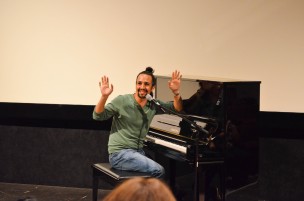"In The Heights" creator returns to preview new music and remember the old.
Lin-Manuel Miranda ’02, lyricist and original star of the Tony Award-winning musical “In the Heights,” began his appearance at Center for the Arts Hall on Tuesday, Sept. 23 with a song he wrote about a seventh-grader’s first unchaperoned party.
Miranda, who double-majored in theater and film, began writing one-act musicals in high school, bringing them to Wesleyan with performances at the WestCo Café. He wrote “In the Heights” while living in La Casa during his sophomore year.
At the event, “When You’re Home: A Look Back on the Origins of In the Heights,” Miranda played songs from his original version of the musical, explaining which parts made it to the final version. As it turns out, the first draft hardly resembled the version that reached Broadway, which, due to the extensive editing process, only contained a few snippets of the initial.
The main difference between the two is the story line itself. Miranda, whose lifelong friend had recently come out to him, described the original storyline as a “90-minute ‘Who am I?’” Only five of the original characters remained after the editing process. As each one dropped out and his or her aspects were split up into other characters, each character’s story line became richer and fuller, resulting in a more complex plot.
Miranda also attributed major plot changes to “Avenue Q,” which he saw while developing “In the Heights.” The plot of a closeted man in love with his best friend, Miranda realized, had just been done—and, in his opinion, it had been done better than in his own show.
Miranda cited Tommy Kail ’99, the director of “In the Heights” for its Broadway and off-Broadway productions, as the main force behind the transition of the musical from the Wesleyan stage to its renditions beyond the University. A week after Miranda graduated, Kail, along with Neil Stewart ’00 and John Mailer ’00, owners of a black box theater in Manhattan, approached Miranda and suggested a series of major changes. The biggest switch was marking Usnavi, originally just a minor character, the narrator.
It was still about the neighborhood of Washington Heights, though, and the music he had written, a combination of Latin and hip-hop resulting from Miranda simply mimicking the music he loved, was still at its heart. With two years’ distance from the original production (as well as two newer plays and a senior thesis), Miranda said he was ready to welcome changes.
The talk opened up to questions from students, who brought up many of his other projects. He discussed his performance this past summer with “Tick, Tick…Boom!,” a pre-“Rent” piece by Jonathan Larson, and his co-writing of “Bring It On,” where he built a song backwards, starting with the beat that the composer wanted and then creating the tune and lyrics. Miranda answered questions on his writing process during the Tony Awards, where he used events that happened throughout the night to quickly create an end-of-the-night rap for Neil Patrick Harris. He also spoke about his new project, a 52-song musical about Alexander Hamilton, narrated by Aaron Burr, in which Miranda will play the central role.
Miranda’s visit is well-timed; a CFA production of “In The Heights” will go up in November. Associate Professor of Theater Claudia Nascimento, director of the upcoming production, said that Wesleyan’s production will be more of a learning experience for those involved than the original.
“A Wesleyan Theater Department production serves a pedagogical mission; it brings together faculty and students in acting, design, directing, dramaturgy, stage management technical practice, and, in the case of ‘In The Heights,’ music,” Nascimento said.
Nascimento arrived at Wesleyan for Miranda’s senior year and has been in touch with him since then, reaching out to both him and Kail for help with the show. Shapiro Distinguished Professor of Writing and Theater Quiara Alegría Hudes, the book writer for “In the Heights,” is also helping out with the show. Hudes is also a close friend of Miranda; he said they realized they had “the exact same childhood, mine in New York and hers in Philly.”
One alteration will be notable, however: Unlike the original, mostly-Latino/a cast, Nascimento said Wesleyan’s production “will reflect the diversity of the Wesleyan student community.”
Throughout his talk in the CFA Hall, Miranda came off as easily relatable, setting up a casual, conversational atmosphere. He, just like his musical, was a hit.
“I just saw a guy with half his hair in a bun forget some of the words to almost all the songs he sang, compare Alexander Hamilton to Tupac, and preview a song from a musical set in the eighteenth century that sounds like an Eminem song,” said Lu Imbriano ’18. “I think I can say I’ve lived.”
